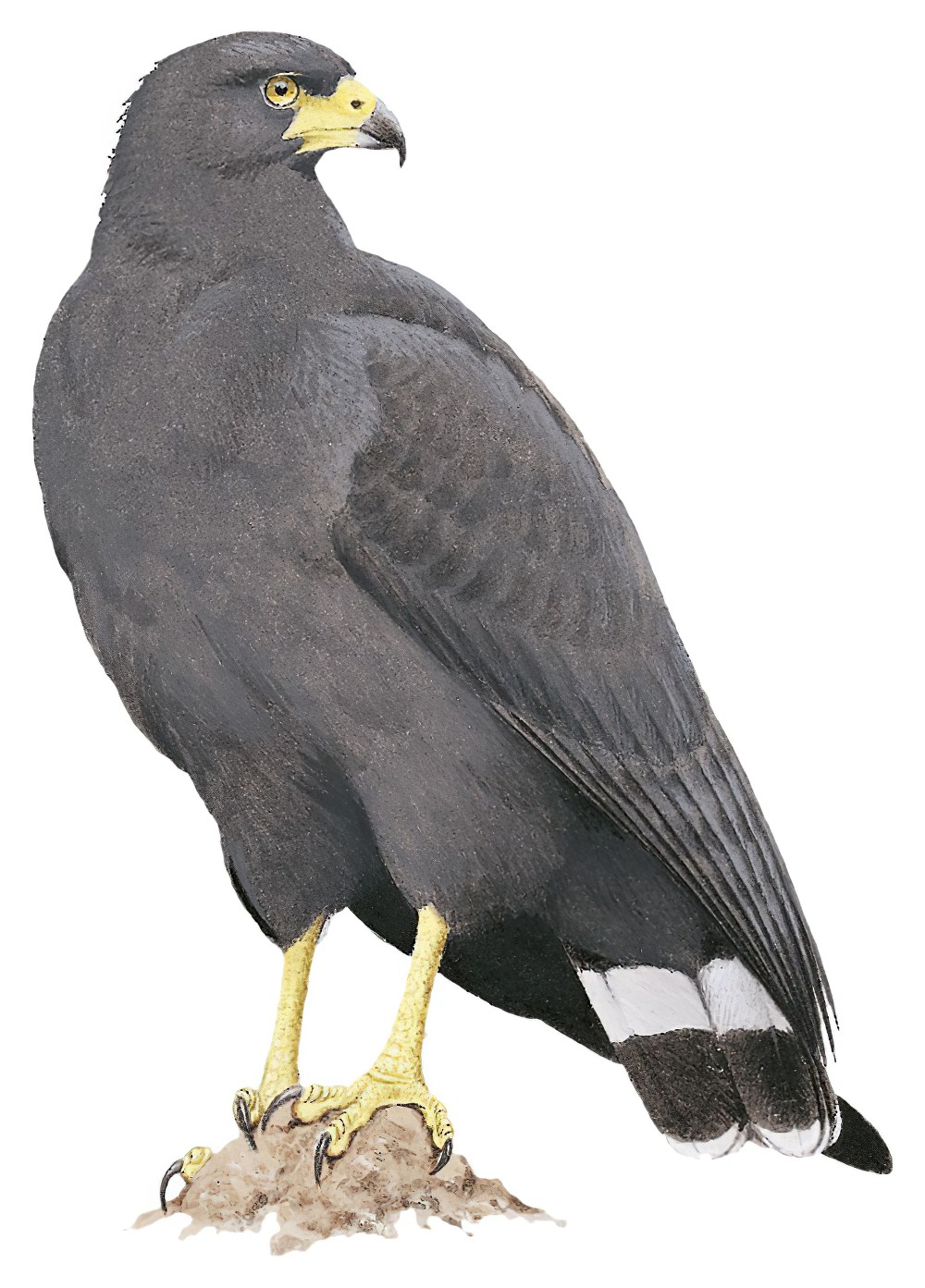Solitary Eagle / Buteogallus solitarius

Solitary Eagle
SCI Name:
Protonym: Circaetus solitarius Arch.Naturgesch. 10 p.264
Taxonomy: Accipitriformes / Accipitridae / Buteogallus
Taxonomy Code: soleag1
Type Locality: Rio Chanchamayo, Junin, Peru.
Author: von Tschudi
Publish Year: 1844
IUCN Status: Near Threatened
DEFINITIONS
BUTEOGALLUS
(Accipitridae; Ϯ Rufous Crab Hawk B. aequinoctialis) Compound of genera Buteo de Lacépède, 1799, buzzard, and Gallus Brisson, 1766, fowl (e.g. turkey); the Rufous Crab Hawk, by reason of its bare face, short tail, small head, heavy body, and long reticulated legs, was considered to resemble the Turkey Vulture (cf. "Buteogallus anthracinus ... A black Buteonine Hawk with exceptional width of wing, long chicken-like yellow legs." (Peterson 1961)); "III.e Sous-genre. BUSON; Buteogallus. Bec long, d'abord droit, à bords renflés pour simuler une dent; mandibule inférieure échancrée au bout; face nue; narines ouvertes, petites, arrondies, dorsales; bec comprimé sur les côtés; ailes concaves, n'atteignant que le milieu de la queue; celle-ci rectiligne, courte; tarses assez longs, emplumés jusqu'au genou seulement, squameux en avant, réticulés sur les côtés et en arrière; tête petite, corps lourd et massif. BUSON CATHARTOÏDE; Buteogallus cathartoides. Falco buson, Lath., Shaw; le Buson, Levaill., Afriq., pl. 21; Caracara buson, Vieill., Encycl., t. III, p. 1182. ... Le buson habite la Guiane (Mus. de Paris; M. Leblond), et le Paraguay, suivant d'Azara, qui le nomme gavilan de estero rozo obscuro." (Lesson 1830); "Buteogallus Lesson, Traité d'Orn., livr. 2, 1830, p. 83. Type, by monotypy, Buteogallus cathartoides Lesson = Falco æquinoctialis Gmelin." (Peters, 1931, I, p. 244).
Synon. Alectromorphnus, Amadonastur, Harpyhaliaetus, Heterospizias, Hypomorphnus, Miraquila, Plangus, Spizageranus, Urubitinga, Urubitornis, Wetmoregyps.
solitaria / solitaris / solitarius
L. solitarius solitary < solus, solius alone.
● According to Fraser in P. Sclater 1859a, the Solitary Shrike Tyrant was called “el Solitario” by the Spanish settlers of Ecuador (Agriornis).
● ex “Coucou Solitaire” of Levaillant 1806, pl. 206 (Cuculus).
● ex “Green-headed Bunting” of Latham 1785 (syn. Emberiza hortulana).
● “Solitary Sparrow ... It is wont to sit alone on the tops of ancient Edifices and Roofs of Churches, singing most sweetly, especially in the Morning, whence it took its name” (Ray 1678); "95. TURDUS. ... solitarius. 14. T. cæruleus, remigibus rectricibusque nigris, abdomine lineolis cinereis undulato. Passer solitarius. Willugb. orn. 191. Raj. av. 66. Edw. av. 18. t. 18. Olin. av. 14. Act. Ups. 1750. p. 21. Habitat in Oriente. Mas cæruleus; Femina cinerea, subtus lineolis albis & cinereis undulata." (Linnaeus 1758) (Monticola).
● (Statius Müller 1776) ex “Merle solitaire de Manille” of d’Aubenton 1765-1781, pl. 564, fig. 2 (syn. Monticola solitarius philippensis).
● (J. Gmelin 1789) ex “Passera solitaria” of Olina 1622, “Solitary Sparrow” of Willughby 1676, “Passer solitarius” of Ray 1713, “Merula solitaria” of Brisson 1760, “Merle solitaire” of de Buffon 1770-1783, and “Solitary Thrush” of Latham 1783 (syn. Monticola solitarius).
● ex “Suirirí chorreado todo” of de Azara 1802-1805, no. 196 (Myiodynastes).
● ex “Solitaire” of Leguat 1708, and de Buffon 1770-1783, and “Solitary Dodo” of Latham 1785: “not met with in flocks, scarcely more than two being found together” (‡Pezophaps).
● ex “Solitary Parrot” of Latham 1787 (Phigys).
● ex “Japú negro” of de Azara 1802-1805, no. 58 (Procacicus).
● ex “Oiseau Solitaire” of Carré 1669, and “Solitaire” of Dubois 1674 (this bird was formerly thought to be a species of dodo Raphus) (‡Threskiornis).
● ex “Ynambú Mocoicogoé” of de Azara 1802-1805, no. 332 (Tinamus).
● "This new species inhabits the watery solitudes of our highest mountains during the summer, from Kentucky to New York" (A. Wilson 1813) (Tringa).
SUBSPECIES
Solitary Eagle (sheffleri)
SCI Name: Buteogallus solitarius sheffleri
sheffleri
William J. Sheffler (1893-?1967) US businessman, sponsor, ornithologist, aviculturalist (syn. Ara militaris mexicanus, subsp. Buteogallus solitarius, subsp. Dendrocolaptes sanctithomae).
Solitary Eagle (solitarius)
SCI Name: Buteogallus solitarius solitarius
solitaria / solitaris / solitarius
L. solitarius solitary < solus, solius alone.
● According to Fraser in P. Sclater 1859a, the Solitary Shrike Tyrant was called “el Solitario” by the Spanish settlers of Ecuador (Agriornis).
● ex “Coucou Solitaire” of Levaillant 1806, pl. 206 (Cuculus).
● ex “Green-headed Bunting” of Latham 1785 (syn. Emberiza hortulana).
● “Solitary Sparrow ... It is wont to sit alone on the tops of ancient Edifices and Roofs of Churches, singing most sweetly, especially in the Morning, whence it took its name” (Ray 1678); "95. TURDUS. ... solitarius. 14. T. cæruleus, remigibus rectricibusque nigris, abdomine lineolis cinereis undulato. Passer solitarius. Willugb. orn. 191. Raj. av. 66. Edw. av. 18. t. 18. Olin. av. 14. Act. Ups. 1750. p. 21. Habitat in Oriente. Mas cæruleus; Femina cinerea, subtus lineolis albis & cinereis undulata." (Linnaeus 1758) (Monticola).
● (Statius Müller 1776) ex “Merle solitaire de Manille” of d’Aubenton 1765-1781, pl. 564, fig. 2 (syn. Monticola solitarius philippensis).
● (J. Gmelin 1789) ex “Passera solitaria” of Olina 1622, “Solitary Sparrow” of Willughby 1676, “Passer solitarius” of Ray 1713, “Merula solitaria” of Brisson 1760, “Merle solitaire” of de Buffon 1770-1783, and “Solitary Thrush” of Latham 1783 (syn. Monticola solitarius).
● ex “Suirirí chorreado todo” of de Azara 1802-1805, no. 196 (Myiodynastes).
● ex “Solitaire” of Leguat 1708, and de Buffon 1770-1783, and “Solitary Dodo” of Latham 1785: “not met with in flocks, scarcely more than two being found together” (‡Pezophaps).
● ex “Solitary Parrot” of Latham 1787 (Phigys).
● ex “Japú negro” of de Azara 1802-1805, no. 58 (Procacicus).
● ex “Oiseau Solitaire” of Carré 1669, and “Solitaire” of Dubois 1674 (this bird was formerly thought to be a species of dodo Raphus) (‡Threskiornis).
● ex “Ynambú Mocoicogoé” of de Azara 1802-1805, no. 332 (Tinamus).
● "This new species inhabits the watery solitudes of our highest mountains during the summer, from Kentucky to New York" (A. Wilson 1813) (Tringa).
UPPERCASE: current genus
Uppercase first letter: generic synonym
● and ● See: generic homonyms
lowercase: species and subspecies
●: early names, variants, mispellings
‡: extinct
†: type species
Gr.: ancient Greek
L.: Latin
<: derived from
syn: synonym of
/: separates historical and modern geographic names
ex: based on
TL: type locality
OD: original diagnosis (genus) or original description (species)












